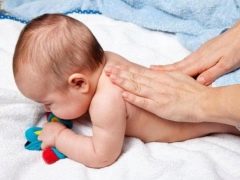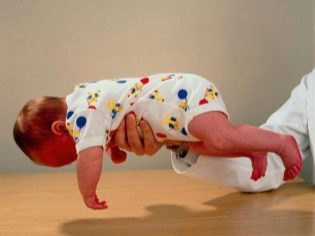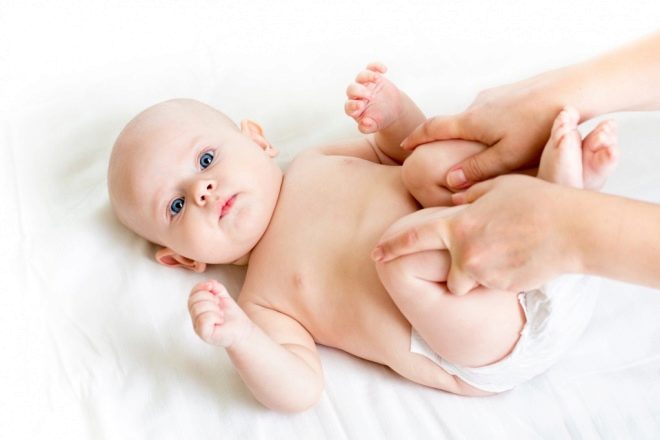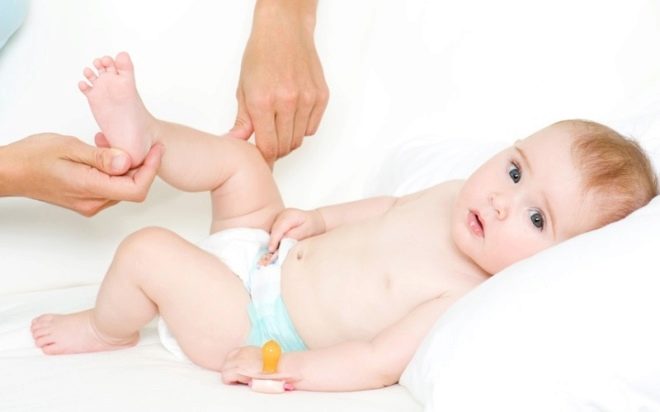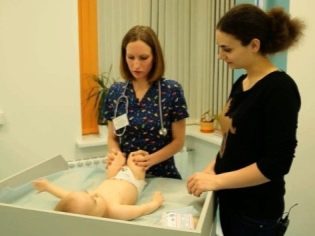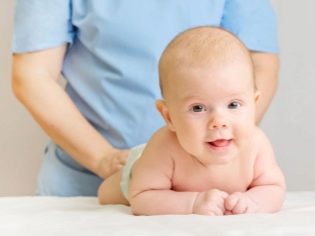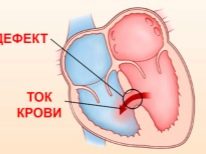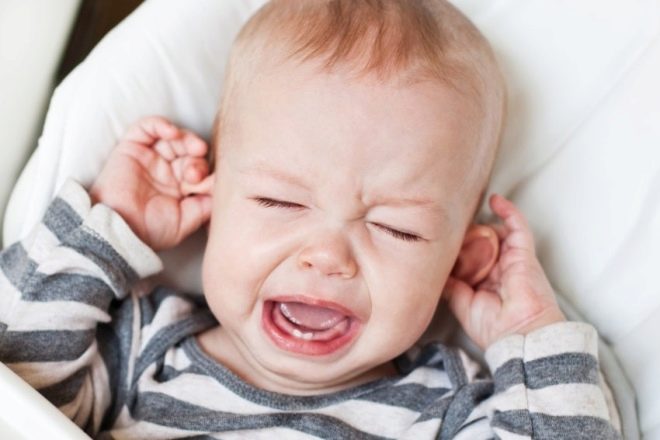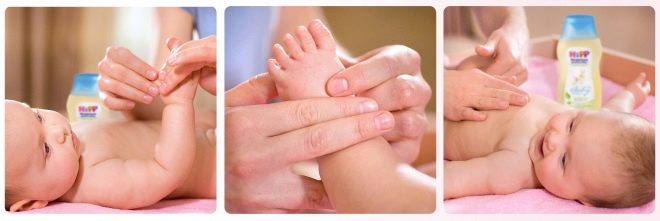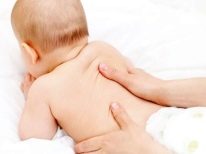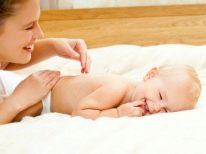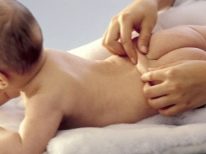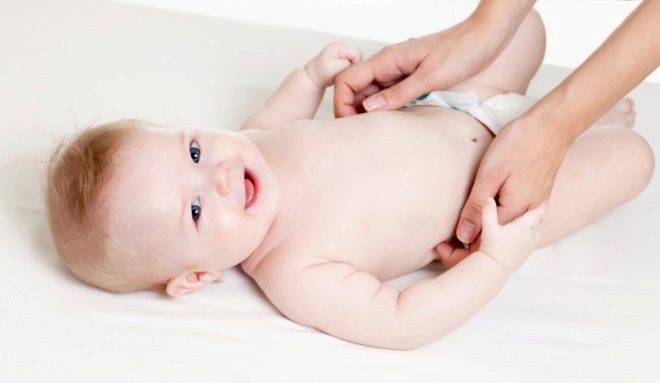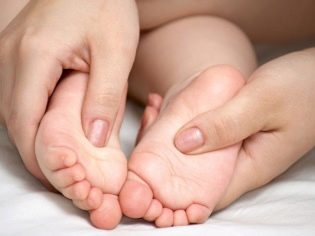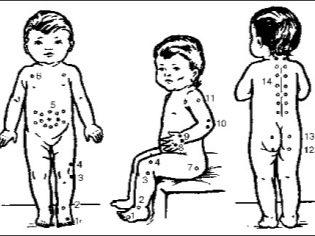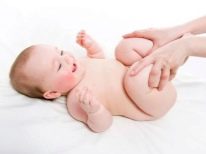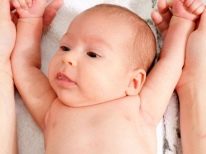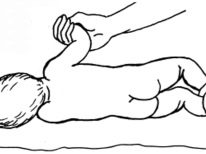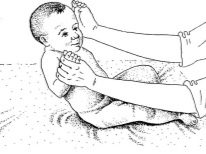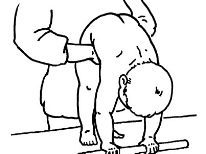Massage and children's gymnastics for muscular dystonia
The condition of muscular dystonia is peculiar to almost all babies up to six months. For some, it persists after. To correct the condition of the crumbs muscles, conservative treatment is prescribed, which is traditionally based on massage and gymnastics. In this article you will learn how to conduct classes with children from birth to one year at home.
About pathology
The concept of "muscular dystonia" is rather voluminous. By this is meant any violation of muscle tone. In newborns, the tone is usually elevated, hypertonus is observed. Such a condition during the first months can be considered physiological, because in the last months of pregnancy in the womb was closely. When it comes to hypertonus, the arms and legs are difficult to bend, sometimes the baby even keeps his fists tightly closed in his sleep.
Another manifestation of muscular dystonia is hypotonia. This is a condition in which muscle tone is insufficient for normal motor activity. This condition is often observed in premature babies, in children born low in weight and very weak. Also, hypotonus can come to shift hypertonus after half a year of a child’s life, if during the first six months his muscles did not experience the necessary load for normal development, or the child was ill and weak for a long time.
In addition, the concept of "muscular dystonia" includes conditions in which the muscles of a child uncontrollably contract. This can be caused by both congenital pathologies of the central nervous system and birth injuries. Thus, dystonia in infants can have both a physiological developmental mechanism and a pathogenic one (due to diseases).
Tonus or hypotonia can manifest itself either in a single muscle or muscle group, or generalized. If a neurologist and a pediatrician claim that the child has dystonia, they should discover its cause, because pathological muscular dystonia requires a slightly different approach to treatment. Although in both cases, the basis will still be gymnastics, massage effects and physiotherapy.
In 95% of cases of detection of muscular dystonia in newborns, the reasons are physiological. After six months, pathology is rarely diagnosed for the first time, but if this happens, then its causes are usually pathological.
The benefits of employment
Massage and gymnastics in the complex act most favorably. In this exercise always begins with performing massage techniques, and only then should we move on to gymnastic exercises. Depending on the type of dystonia (hypertonicity or hypotonia), either a relaxing or tonic and tonic massage for children and an appropriate set of exercises from the arsenal of physical therapy are prescribed.
Classes with a child can remove the increased muscle tone in hypertonicity, relax muscle tissue. The relaxing effect will be not only muscular, but also general, beneficially affecting the general well-being of the child - sleep, appetite will improve, the baby will become more calm. In case of muscular dystonia, according to the type of reduced tone, blood circulation in the muscles improves, muscle tissue becomes stronger, metabolic processes are accelerated.
Gymnastics helps to consolidate the correct state of muscle tone at the level of neural memory - the muscles of the baby’s legs and arms, his back, abdomen, and the neck area “remember” the correct position in a state of rest and activity.
To remove an increased tone or improve a reduced one is very important as soon as possible. Children with muscular dystonia develop more slowly physically, new skills are more difficult for them - they are late in mastering crawling, sitting, standing, independent steps. Delay in physical development can lead to delayed mental and emotional development.
Indications and contraindications
Since hypertonus is found in all newborns, massage is basically necessary for everyone, although the well-known doctor Komarovsky believes that it is possible to do without him, because the physiological (not caused by neurological diseases) muscle tone passes by itself, and this usually happens by 4-5 months child's life. But the desire of parents to help the child to cope with the signs of dystonia is quite understandable, and therefore worthy of respect and assistance.
With hypotone massage more grounds, because the weakness of muscle tissue is an alarming symptom. Without parental involvement, the muscles gradually “catch up”, but the process can be very long.
If the doctor claims that the child has pathological dystonia, then he should voice a specific diagnosis, a symptom of which was, in fact, this dystonia. If it is paralysis, cerebral palsy, paresis, then the massage is prescribed by a professional, therapeutic, which the mother should be trained by certified masseurs. Inappropriate effects can worsen the child's well-being and aggravate the problem. For healthy babies, massages are performed with a general, prophylactic, not requiring the participation of a professional masseuse. Mom can make his baby herself.
The list of contraindications includes the conditions and diseases in which the massage can not be done:
- period of illness, weakness, fever;
- teething period;
- skin rashes, extensive hemorrhage, eczema, rashes, blisters and pustules, as well as allergic rashes, abrasions and burns;
- congenital heart defects and vascular anomalies;
- increased convulsive readiness, diagnosed or suspected epilepsy;
- blood diseases associated with a high invasiveness of the walls of blood vessels and a reduced ability of blood to coagulate;
- large hernia - umbilical, inguinal, spinal and others.
Premature and low birthweight babies need to gain the necessary weight before starting classes, so only the doctor determines the right time for them to start classes, the parents' independence in this matter is discouraged.
Massage is not done if the child slept poorly at night, ate poorly, if he was sick or had diarrhea. A child who is in a bad mood and is naughty, it is recommended to transfer massage procedures and gymnastics to a later time, when the baby will be more complacently set for the upcoming lesson.
How to do?
With hypertonus and hypotone massage begin the same way - the fundamental differences will be at the end of the procedure.
Lay the baby on his back. With moisturized or creamy hands, start with general strokes. The direction of hand movements is from bottom to top.
The first to massage the arms and legs. At first, they easily rub fingers of hands, palms, pass to hands and forearm. After light circular and undulating rubbing, rubbing with a slight pressure can be applied. Make sure the child does not hurt. Armpits can not be massaged. Massage of the legs begins with the foot, by analogy with the hands, the lower limbs are massaged upwards, avoiding touching the popliteal cavities. The knee joint is not massaged, but only easily stroked with your fingers in a circle without pressure.
The chest and abdomen is massaged with an open palm, in circular and vitcoobraznye movements. At 3 months, you can add to these techniques light stroking movements in the neck area and neck.
Put the baby on the belly. Massage your back with your palms and their backs, rubbing them from bottom to top. Pressure and effects on the vertebrae, lower back and cervical vertebrae should be avoided.With hypertonia, pay attention to massage the lower legs and the back of the forearms. From 3-4 months permissible kneading of the muscles by grabbing their fingers and a small stretch. With hypotoneus, clapping and pinching are helpful.
Bring the child back, perform general stroking movements with his hands to relax after the procedure and go to the gym.
Massage technique is quite simple. The difference between toning and relaxing effects is a deeper effect on the muscles with reduced their tone. You can apply rubbing with the edges of the palms (the so-called sawing), deep kneading, the main thing is to carry out such techniques at the very end of the session, when the muscles are warm enough and the blood supply has increased.
If desired, gymnastics can be supplemented with acupressure elements, for example, to massage the head (avoiding springs) with fingertips, as well as foot massage with a circular finger effect on the lifting of the foot, on the base of the metatarsal bones, on the heel to the ankle.
Increase the session time gradually, do not rush, add 1-2 minutes daily. If at the very beginning of the session will last 3-4 minutes, then in a month its duration will increase to 10-15 minutes.
Gymnastics Exercise
All gymnastic exercises for babies are divided into passive and active. The former imply the performance of exercises to a lying baby, the latter - the direct involvement of the infant itself in the exercise.
With hypertonus, try to conduct more passive gymnastic exercises, with insufficient muscle tone, try to strain them to a greater extent by organizing active exercises for your child using his age-related skills and abilities. By active exercises in accordance with the general rule of exercise therapy, they are transferred only after a passive set of exercises.
With increased tone, do stretching the muscles and increase their elasticity. These include:
- lifts of handles and legs up;
- leg breeding;
- bringing the legs to the stomach synchronously or alternately ("bicycle");
- laying out on a tummy.
In case of muscular dystonia by the type of reduced tone, in addition to the exercises listed above, suggest that the child do what he can by age:
- in 2-3 months, lying on your stomach, follow the toy, reach for it;
- in 4-5 months to make revolutions on the side and on the back from the position on the stomach behind the toy;
- in six months sit down baby;
- at any age encourage and encourage them to make crawling movements;
- in 10-12 months, spend with the baby tilts behind the toy, make the first steps with it, with the support, if the crumb still does not walk.
Fitball charging is permissible for children of any age, excluding newborns. This complex refers to the dynamic gymnastics. Ask your doctor if your baby can play on the gym ball because dynamic techniques have a larger list of contraindications than general gymnastics.
General rules
To achieve the desired result, it is important to make the lessons systematic. Compliance with simple rules will help put in order muscle tone and do it with pleasure for all:
- Maintain in the room where classes are held, the optimum temperature and humidity (temperature not higher than 21 degrees, humidity - 50-70%). Be sure to ventilate the room before the massage. In the summer, if possible, conduct a lesson on the street.
- Use the changing table for a massage, but if not, you can hold a session on a regular table or even on the lid of the dresser. Requirement one - the surface should not be soft and uneven.
- Use only hypoallergenic oils or baby massage cream.
You can use vegetable oil, but after it the child must be bathed in order to remove the thin air-tight oily layer from the skin.
- Any exercise spend in the form of a game - this applies to massage and gymnastics.If the child is uninteresting, unhappy, then he will very quickly make it clear that he is pretty tired of everything that happens, will begin to be capricious and will have to interrupt the activity. Remember that massage and gymnastics is a reason for communication, which should develop not only the body, but also the psyche of the toddler, as well as his emotional sphere.
- Remember safety. Always put everything you need to close, so as not to leave the baby alone on the table, falling from which can lead to injury.
- Conduct classes one hour after eating to avoid regurgitation, and no later than one hour before bedtime. Massage toning do not do at night.
Before evening bathing, only relaxing techniques are allowed in the complete absence of subsequent gymnastic exercises.
For information on how to do a baby massage for muscular dystonia, see the following video.
